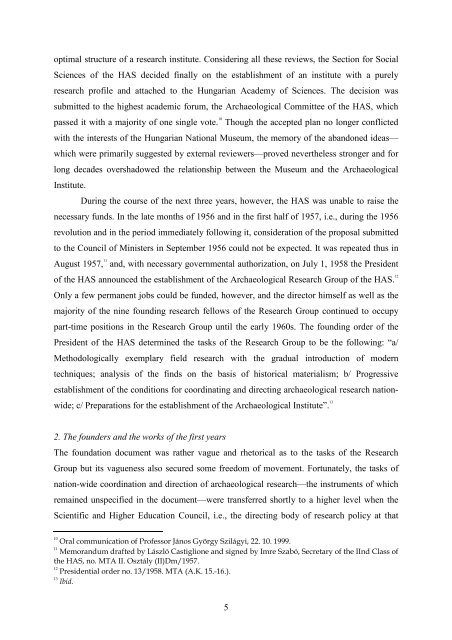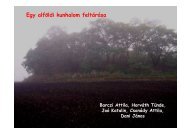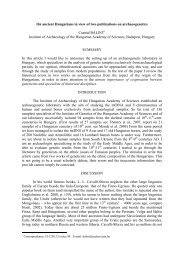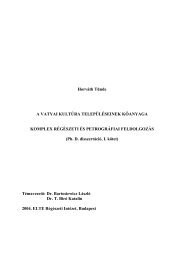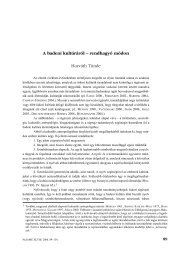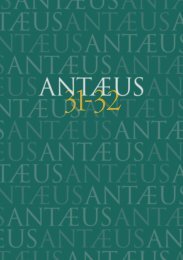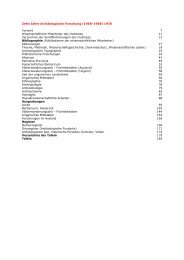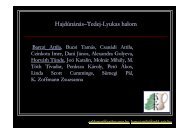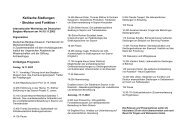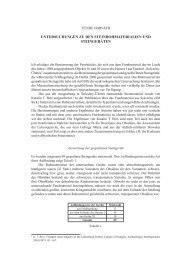The first forty-one years, 1958-19991 1. T - MTA Régészeti Intézet
The first forty-one years, 1958-19991 1. T - MTA Régészeti Intézet
The first forty-one years, 1958-19991 1. T - MTA Régészeti Intézet
Create successful ePaper yourself
Turn your PDF publications into a flip-book with our unique Google optimized e-Paper software.
optimal structure of a research institute. Considering all these reviews, the Section for Social<br />
Sciences of the HAS decided finally on the establishment of an institute with a purely<br />
research profile and attached to the Hungarian Academy of Sciences. <strong>The</strong> decision was<br />
submitted to the highest academic forum, the Archaeological Committee of the HAS, which<br />
passed it with a majority of <strong>one</strong> single vote. 10<br />
Though the accepted plan no longer conflicted<br />
with the interests of the Hungarian National Museum, the memory of the aband<strong>one</strong>d ideas—<br />
which were primarily suggested by external reviewers—proved nevertheless stronger and for<br />
long decades overshadowed the relationship between the Museum and the Archaeological<br />
Institute.<br />
During the course of the next three <strong>years</strong>, however, the HAS was unable to raise the<br />
necessary funds. In the late months of 1956 and in the <strong>first</strong> half of 1957, i.e., during the 1956<br />
revolution and in the period immediately following it, consideration of the proposal submitted<br />
to the Council of Ministers in September 1956 could not be expected. It was repeated thus in<br />
August 1957, 11 and, with necessary governmental authorization, on July 1, <strong>1958</strong> the President<br />
of the HAS announced the establishment of the Archaeological Research Group of the HAS. 12<br />
Only a few permanent jobs could be funded, however, and the director himself as well as the<br />
majority of the nine founding research fellows of the Research Group continued to occupy<br />
part-time positions in the Research Group until the early 1960s. <strong>The</strong> founding order of the<br />
President of the HAS determined the tasks of the Research Group to be the following: “a/<br />
Methodologically exemplary field research with the gradual introduction of modern<br />
techniques; analysis of the finds on the basis of historical materialism; b/ Progressive<br />
establishment of the conditions for coordinating and directing archaeological research nationwide;<br />
c/ Preparations for the establishment of the Archaeological Institute”. 13<br />
2. <strong>The</strong> founders and the works of the <strong>first</strong> <strong>years</strong><br />
<strong>The</strong> foundation document was rather vague and rhetorical as to the tasks of the Research<br />
Group but its vagueness also secured some freedom of movement. Fortunately, the tasks of<br />
nation-wide coordination and direction of archaeological research—the instruments of which<br />
remained unspecified in the document—were transferred shortly to a higher level when the<br />
Scientific and Higher Education Council, i.e., the directing body of research policy at that<br />
10<br />
Oral communication of Professor János György Szilágyi, 22. 10. 1999.<br />
11<br />
Memorandum drafted by László Castigli<strong>one</strong> and signed by Imre Szabó, Secretary of the IInd Class of<br />
the HAS, no. <strong>MTA</strong> II. Osztály (II)Dm/1957.<br />
12<br />
Presidential order no. 13/<strong>1958</strong>. <strong>MTA</strong> (A.K. 15.-16.).<br />
13<br />
Ibid.<br />
5


